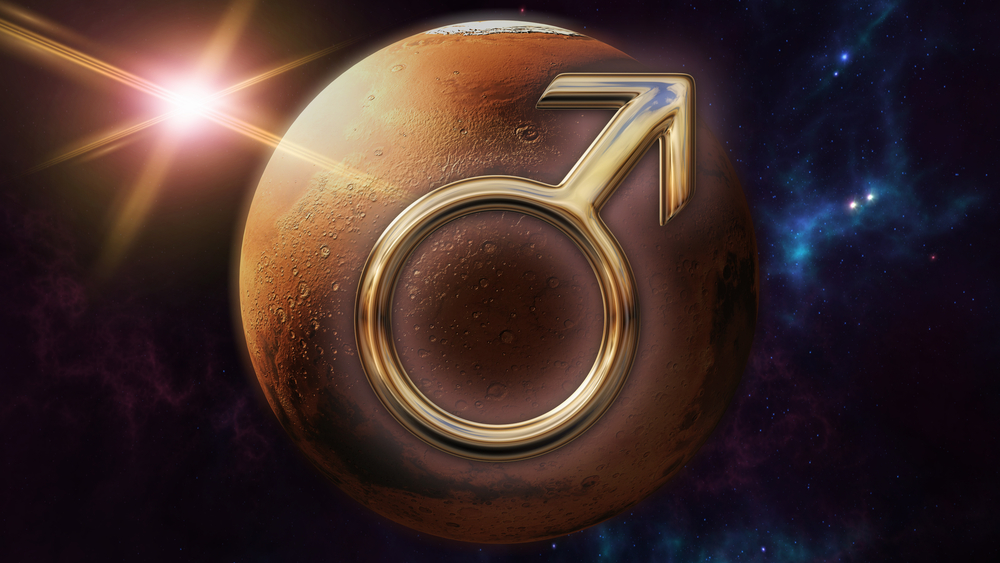
for their god of war.
NASA’s Opportunity Rover made headlines worldwide in February 2019. Tasked with roaming Mars’s surface for 90 days, the rover traveled and collected data for 15 more years. Oppy’s final message was a stream of technical data. Science reporter Jacob Margolis poetically translated this transmission: “My battery is low and it’s getting dark.” Oppy is the latest attempt to understand the fourth planet, which has long fascinated humanity. Yet Mars holds a deeper astrological meaning for people all over the globe.
Mars: Basic Facts and History
NASA reveals that the planet’s red color comes from oxidized iron present in the soil. It takes almost two years to complete a trip around our sun, with an orbital period of 687 Earth days. Its rocky surface has seen volcanic eruptions, high winds, meteor impacts, and seismic activity. With a thin atmosphere that can’t retain heat, surface temperature extremes are common. These can reach up to 68 degrees Fahrenheit at the equator during its summers. Conversely, they can plummet to minus 195 degrees Fahrenheit at the poles during winter.
Before Galileo saw Mars through his telescope, ancient cultures observed this red planet. The Babylonians called it Nergal after their god of war, death, and destruction. Referring to it as “Horus the Red,” the Egyptians recorded its apparent retrograde motion. Egyptian star maps dating to 1534 B.C.E. show the planet’s position. Calling it a “fire star,” the Chinese observed its planetary conjunctions at least three thousand years ago. This Library of Congress article explains that the Greeks classified Mars and other planets as wandering stars. When the Romans adopted astrology and astronomy, they named the planet for their god of war.
The Red Planet’s Astrological Impacts
According to Mystica Astrology blogger Emma Wilson, Mars symbolizes drive, motivation, and aggression. It can also represent the energy an individual puts toward passions and goals. Mars also rules the constellation Aries, characterized by compulsive and creative energies. Unsurprisingly, Mars and Aries also govern the first house of the horoscope. Astrostyle points out that this house represents “firsts,” including impressions, initiatives, and self-development.
Every natal chart displays Mars’s position at the time of an individual’s birth. As with other celestial bodies, its effects combine with its resident houses and signs. The Astro Codex describes several examples of these. Mars in Virgo brings precision and stamina that manifests as perseverance, dedication, and clarity. Mars in Sagittarius lends energies to learning and exploration but may manifest as boredom and instability. The first house also governs the self, so a Mars placement produces a dynamic, straightforward, and independent person. Yet Mars in the 12th house may result in fear of victimization or imploding anger.
Mars takes about 45 days to travel through each zodiac sign, but retrogrades can affect its path. The Cut’s Claire Comstock-Gay clarifies that a retrograde slows a planet’s energies or turns them inward. Mars’s typical effects can feel diminished or scattered during these times. Astrologers believe this could result in second-guessing, self-doubt, or holding back. However, Cafe Astrology proposes that Mars retrogrades afford opportunities for introspection and rest. Within a natal chart, a Mars retrograde takes on other meanings. The Astro Codex states that it can signify someone who is slow to anger, represses this emotion, or lacks self-confidence.
Understanding the Human Psyche
Modern scholars dismiss astrology as a pseudoscience, but adults under 35 show great interest in the subject. Astrological explanations may help people make sense of a frightening and chaotic world. Perhaps the divine and planetary symbolism have other purposes. It’s been said that we create deities in our own images. Indeed, these divine beings and the planets representing them are another way to visualize aspects of the human mind and heart.

